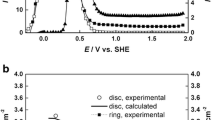Abstract
We describe the measurement of electronic conductivity of solid oxide electrolytes by a modified Hebb-Wagner technique based on the use of blocking microelectrodes. Results are presented for a couple of typical solid oxide electrolyte systems mainly derived from ceria and lanthanum gallate. The examples demonstrate a good resolution of the microelectrode technique in particular within the electrolyte domain, i.e. around the minimum of the electronic conductivity. This made possible the detection of deviations from the predicted oxygen partial pressure dependence of simple defect models for the concentrations of electrons and holes. The observed deviations from these defect models, at least partially, reflect the overemphasized ideality of the usually applied semiconductor model.
Whereas the effect of dissolved transition metals with variable valence states such as Fe, and Co on the electronic conduction is well known, it was unexpected to find a strong concentration dependent effect of dopants like Y3+ and Zr4+ in ceria or Mg2+ and Sr2+ in the gallates upon the electronic conductivity within the electrolytic domain. Ions like Y3+ and Zr4+ cause a shift and a partial broadening of electronic states in ceria based materials. Indications have been found for band tailing due to high defect concentrations. In some cases, the dopants cause the appearance of additional localized electron states in the gap which give rise to weak superimposed maxima of the electronic conductivity at a particular oxygen partial pressure within the electrolytic domain.
Accordingly, one cannot expect that electronic conductivities of solid electrolytes are insensitive to a changing concentration of stabilizers such as Y, Ca, etc. For instance, even a moderate doping of ceria by zirconia leads to a considerable electronic excess conductivity in the electrolytic domain.
Similar content being viewed by others
References
M. H. Hebb, J. Chem. Phys. 20, 1952 (1952).
C. Wagner, in Proc. of the 7th Meeting of the International Committee on Electrochemical Thermodynamics and Kinetics, Lindau, 1955), p. p. 361ff.
H. Schmalzried, Z. Phys. Chem. N.F. 38, 87 (1963).
J. B. Wagner and C. Wagner, J. Chem. Phys. 26, 1597 (1957).
B. Ilschner, J. Chem. Phys. 28, 1109 (1958).
J. W. Patterson, E. C. Bogren, and R. A. Rapp, J. Electrochem. Soc. 114, 752 (1967).
L. D. Burke, H. Rickert, and R. Steiner, Z. phys. Chem. N.F. 74, 146 (1971).
L. Heyne and N. M. Beekmans, Proceedings of the British Ceramic Society 19, 229 (1971).
F. Schilling, U. Vohrer, H.-D. Wiemhoefer, J. Arndt, and W. Goepel, Sensors and Actuators B 4, 411 (1991).
U. Vohrer, H.-D. Wiemhoefer, W. Goepel, B. A. van Hassel, and A. J. Burggraaf, Solid State Ionics 59, 141 (1993).
X. Guo and J. Maier, Solid State Ionics 130, 267 (2000).
K. Kobayashi, S. Yamaguchi, T. Higuchi, S. Shin, and Y. Iguchi, Solid State Ionics 135, 643 (2000).
K. Sasaki and J. Maier, Solid State Ionics 134, 303 (2000).
T. S. Stefanik and H. L. Tuller, Journal of the European Ceramic Society 21, 1967 (2001).
P. Knauth and H. L. Tuller, Solid State Ionics 136, 1215 (2000).
O. Porat, M. A. Spears, C. Heremans, I. Kosacki, and H. L. Tuller, Solid State Ionics 86–88, 285 (1996).
H. L. Tuller, Solid State Ionics 94, 63 (1997).
H. Nafe, Solid State Ionics 59, 5 (1993).
N. J. Long, F. Lecarpentier, and H. L. Tuller, Journal of Electroceramics 3, 399 (1999).
N. Trofimenko and H. Ullman, Solid State Ionics 118, 215 (1999).
H. Ullmann, N. Trofimenko, A. Naoumidis, and D. Stover, Journal of the European Ceramic Society 19, 791 (1999).
K. Schindler, D. Schmeiβer, U. Vohrer, H.-D. Wiemhoefer, and W. Goepel, Sensors and Actuators 17, 555 (1989).
H.-D. Wiemhoefer and U. Vohrer, Ber. Bunsenges. Phys. Chem. 96, 1646 (1992).
H.-D. Wiemhoefer, S. Harke, and U. Vohrer, Solid State Ionics 40/41 (1990).
P. W. Anderson, Physical Review 109, 1492 (1958).
S. N. Mott, M. Pepper, S. Pollitt, R. H. Wallis, and C. J. Adkins, Proc. Roy. Soc. Lond. A 345, 169 (1975).
S. Luebke and H. D. Wiemhoefer, Solid State Ionics 117, 229 (1999).
J. Weitkamp and H.-D. Wiemhoefer, Solid State Ionics 154–155C, 597 (2002).
S. Luebke and H. D. Wiemhoefer, Berichte Der Bunsen-Gesellschaft-Physical Chemistry Chemical Physics 102, 642 (1998).
J. H. Lee, S. M. Yoon, B. K. Kim, H. W. Lee, and H. S. Song, Journal of Materials Science 37, 1165 (2002).
H. Yokokawa, N. Sakai, T. Horita, K. Yamaji, Y. P. Xiong, T. Otake, H. Yugami, T. Kawada, and J. Mizusaki, Journal of Phase Equilibria 22, 331 (2001).
Y. P. Xiong, K. Yamaji, N. Sakai, H. Negishi, T. Horita, and H. Yokokawa, Journal of the Electrochemical Society 148, E489 (2001).
N. Sakai, T. Hashimoto, T. Katsube, K. Yamaji, H. Negishi, T. Horita, H. Yokokawa, Y. P. Xiong, M. Nakagawa, and Y. Takahashi, Solid State Ionics 143, 151 (2001).
J. H. Lee, S. M. Yoon, B. K. Kim, J. Kim, H. W. Lee, and H. S. Song, Solid State Ionics 144, 175 (2001).
K. Kawamura, K. Watanabe, T. Hiramatsu, A. Kaimai, Y. Nigara, T. Kawada, and J. Mizusaki, Solid State Ionics 144, 11 (2001).
C. E. Hori, K. Y. S. Ng, A. Brenner, K. M. Rahmoeller, and D. Belton, Brazilian Journal of Chemical Engineering 18, 23 (2001).
A. Tsoga, A. Naoumidis, and D. Stover, Solid State Ionics 135, 403 (2000).
T. Otake, H. Yugami, H. Naito, K. Kawamura, T. Kawada, and J. Mizusaki, Solid State Ionics 135, 663 (2000).
Author information
Authors and Affiliations
Rights and permissions
About this article
Cite this article
Wiemhoefer, HD., Dogan, M., Luebke, S. et al. New Results for Electron Transport, Chemical Diffusion and Stability of Solid Oxygen Ion Conductors. MRS Online Proceedings Library 756, 16 (2002). https://doi.org/10.1557/PROC-756-EE1.6
Published:
DOI: https://doi.org/10.1557/PROC-756-EE1.6




